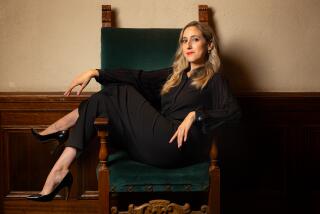TV REVIEW : ‘Rite of Spring’ on PBS Tonight
American dance has always taken genius for granted, forever pushing toward new artistic frontiers and discarding any previous achievements that seemed dated. Increasingly, however, cultural historians have worked to reclaim lost artifacts of dance history, aware in an era of conservation that creative greatness is just as perishable a resource as fossil fuel.
Crowning this interest in restoration and revival was a dance-reconstruction of miraculous proportions: the legendary, short-lived 1913 Vaslav Nijinsky choreography for “Le Sacre du Printemps,” pieced together from the most meager and scattered evidence imaginable. The background of both the original Paris production and the 1987 re-creation for the Joffrey Ballet forms an introduction to a studio-taped performance on “The Search for Nijinsky’s ‘Rite of Spring’ ” tonight on PBS “Dance in America” (9:30 on KCET Channel 28).
With Nicholas Roerich’s stage designs enlarged to sound-stage proportions, this “Sacre” has a different look than in the theater--and a different rhythm. Much of the work is devoted to formal group dancing: the hardest kind of choreography to make legible on the small screen. Director Thomas Grimm and editor Katarina Jonsson attempt to solve the problem by emphasizing short takes of small groups, and by carefully synchronizing their camera-cutting to Igor Stravinsky’s score.
This approach deprives the viewer of the work’s brilliant movement-counterpoint, but it helps isolate Nijinsky’s motifs and keeps lucid the relationship between dance and music. It gives us the building-blocks of “Sacre,” if not the architecture. Led by Beatriz Rodriguez as the Chosen One, the Joffrey forces dance with a fervor that suggests the ritualistic power the ballet can attain on stage.
Directed by Judy Kinberg and written by Holy Brubach, the documentary prologue is far less successful: superficial, badly organized, full of platitudes without ever really defining the artistic importance of the ballet under discussion.
It does, however, have Millicent Hodson and Kenneth Archer patiently explaining their research on “Sacre”: the mixture of detective-work and educated guesses that led to the Joffrey production. Best of all, it has familiar but invaluable interview footage of Stravinsky and Marie Rambert (Nijinsky’s assistant on “Sacre”) that conveys the turbulent circumstances of the work’s creation and premiere.
More to Read
The complete guide to home viewing
Get Screen Gab for everything about the TV shows and streaming movies everyone’s talking about.
You may occasionally receive promotional content from the Los Angeles Times.






